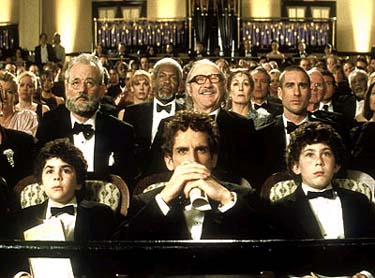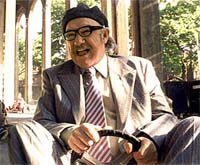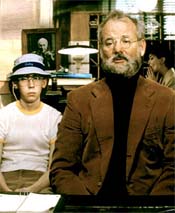 |


|
|
|
|
Film Review by John Demetry
Anderson establishes the narrative as that of a novel read by someone off-screen - the space the audience inhabits. By looking through Anderson's enchanting artifice, the spectator discovers a common yearning - a shared truth - within a distinctly constructed worldview. Anderson's intuitive connection: the longing to express often comes with the failure to express longing. In The Royal Tenenbaums, Anderson provides a fresh perspective on privilege, disappointment, and pop by applying his unique expressiveness to the resulting emotional confusion of a family of unfulfilled genius. Finding fresh means of expression constitutes the dilemma of the characters in The Royal Tenenbaums. Sample dialogue: Luke Wilson as Richie Tenenbaum: "Did you tell Margot about that letter I wrote you?" Owen Wilson as the Tenenbaums' neighbor Eli Cash: "Why? Did she mention it?"
Such transparently evasive speech and action is Anderson's and actor/co-screenwriter Owen Wilson's comic specialty. The technique resounds throughout - humorously, yet poignantly. Danny Glover as the Tenenbaums' accountant proposes to Ethel Tenenbaum (Anjelica Huston) by introducing the economic advantages. Ethel's estranged husband, Royal (Gene Hackman), challenges her suitor to some "jive talk."
Anderson's tableau style intentionally recalls New Yorker cover art and cartoons. Example: Hackman and Huston strolling in the park wearing Karen Patch's iconic costumes. Anderson beautifully integrates the tableaus into his consideration of family dynamics. Cinematographer Robert D. Yeoman's Cinemascope renderings of isolation and interaction tickle perception. When son Chas (Ben Stiller) argues with Royal in a closet packed top-to-bottom with abandoned board games, it's like a homey, humble version of Bernardo Bertollucci's extravagant surrealism. With that shot, Anderson might have finally fulfilled his dream of winning over the late New Yorker film critic Pauline Kael. Anderson knows what it means to want to be loved; it means to want to be understood. The opening tableaus detail the different quirks of the Tenenbaum children, over-achieving to define their identities amidst parental estrangement. Anderson scores the sequence to Elliot Smith's cover of the Beatles' momentous "Hey Jude."
Through this process, Anderson explores the space between emotion and expression, flesh and feeling in the temporal change from promise to disappointment to hope. It's so affecting that when the Cinemascope lens stretches the screen from foreground to background focus, the eyes and heart palpitate in unison. Gwyneth Paltrow plays Margot, who writes plays that make public her longing for the acknowledgement of Royal, her adoptive father. (The 12-year-old Margot's first play features her taking a bow in the role of a zebra with bloody wounds painted on her costume.) Paltrow's spindly bone structure and pale white skin - accented with thick black eyeliner - aptly reflect "New Yorker" illustrations - and New Yorker-class objects of desire. Anderson signifies this with the portraits that the young Richie obsessively paints of his adopted sister. Anderson conveys the emotional essence of those who desire and of those desired. He develops a complicated pop expression with the sequence of Luke Wilson shaving off his '60s-retro long hair and beard. Preparing to slit his wrists in front of a mirror, Richie reveals both his pathetic narcissism and his desperate need for connection. Anderson's genius: his treatment of Luke Wilson's physique and face make it an unaccountably sexy screen moment. (A friend recalled his three times seeing the movie by exclaiming: "Luke Wilson shaving!!") Scored to the Rolling Stones' "Ruby Tuesday," Margot and Richie share their tender befuddlement in an illuminated yellow tent, pitched - "Norwegian Wood"-style - in the room adorned with Richie's portraits of Margot. Anderson's pop-surrealism provides the emotional space to generate the performers' imaginative, erotic empathy.
 The cast of The Royal Tenenbaums
The cast of The Royal Tenenbaums
It matches up with the moment that Stiller strips away Chas' ubiquitous red jogging suit: "I've had a rough year, Dad." That line precedes Anderson's climactic tableau: a tracking shot packed - helter-skelter - with visual resolutions of intimate and narrative confusions. Sample detail: Royal replaces Chas' dead dog with a Dalmatian, subliminally recalling the spotted mice Chas genetically engineered as a youngster. It's not just pictorial, but emotionally - and yes, dammit, politically - piquant. A moment in the epilogue fully reveals Anderson's personal grasp on humor and pathos. Margot's new play premieres in a quick succession of three shots. Shot one: A character based on Royal introduces the Margot character to a group of African natives as his "adopted daughter." Shot two: The real Royal in the audience laughs. The rest of the audience is silent. Shot three: Margot waits outside the theatre alone. The ricochet of filmmaker and spectator self-perception in The Royal Tenenbaums reveals what's truly special about Young Mr. Anderson. The man has got rubber soul. |

© 1997-2002 BEI
 Gene Hackman plays Royal, the patriarch of the Tenenbaums
Gene Hackman plays Royal, the patriarch of the Tenenbaums  Bill Murray plays psychologist Raleigh St. Clair, here with a patient played by Stephen Lea Sheppard
Bill Murray plays psychologist Raleigh St. Clair, here with a patient played by Stephen Lea Sheppard